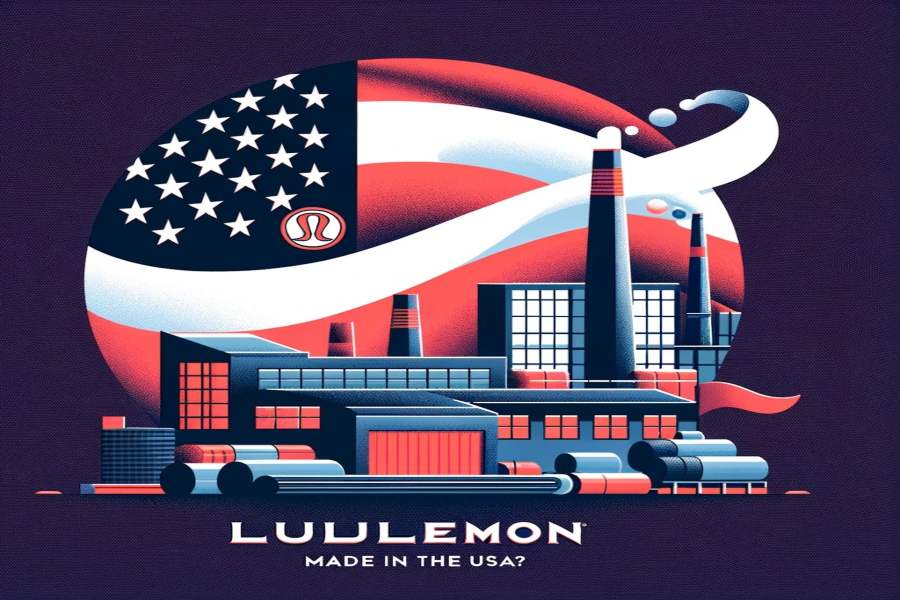Lululemon Athletica, a renowned brand known for its high-quality athletic wear, has a loyal customer base that often wonders about the origins of its beloved products. As consumers become increasingly conscious of where their clothing is made, the question “Is Lululemon made in the USA?” frequently arises.
This article aims to answer this question comprehensively while exploring the intricacies of Lululemon’s manufacturing process. We’ll delve into the company’s history, the locations of their production facilities, and the implications of their manufacturing choices. Whether you’re a dedicated Lululemon fan or a curious consumer, this detailed exploration will provide you with the information you need to make informed decisions about your purchases.
Is Lululemon Made in the USA?
Lululemon is not made in the USA. Most of their products are manufactured in countries like Vietnam, China, and Cambodia. However, they ensure high-quality standards across all production facilities.
The Origins and Evolution of Lululemon
Lululemon Athletica was founded in Vancouver, Canada, in 1998 by Chip Wilson. The company initially focused on creating high-quality yoga wear, which quickly gained popularity due to its innovative designs and superior fabric technology. As demand grew, Lululemon expanded its product line to include a wide range of athletic apparel and accessories.
The brand’s commitment to quality and performance has been a driving force behind its success. Lululemon’s proprietary fabrics, such as Luon and Nulu, are designed to provide comfort, flexibility, and durability. These innovations have set Lululemon apart in the competitive activewear market, making it a favorite among athletes and fitness enthusiasts worldwide.
Despite its Canadian origins, Lululemon’s manufacturing footprint extends far beyond North America. The company has strategically chosen production locations to optimize cost, efficiency, and quality. This global approach to manufacturing allows Lululemon to maintain its high standards while meeting the growing demand for its products.
Over the years, Lululemon has faced scrutiny regarding its manufacturing practices, particularly concerning labor conditions and environmental impact. The company has responded by increasing transparency and implementing more stringent supplier standards. These efforts aim to ensure that all workers involved in the production process are treated fairly and that environmental sustainability is prioritized.
In conclusion, while Lululemon originated in Canada, its manufacturing network spans several countries, primarily in Asia. This global approach allows the brand to continue delivering high-quality, innovative products to its customers.
Where is Lululemon Made?
Global Manufacturing Network Lululemon’s products are primarily manufactured in various Asian countries. The brand has partnered with factories in Vietnam, China, Cambodia, and other regions. These locations are chosen for their textile production expertise and ability to meet Lululemon’s rigorous quality standards.
Quality Control and Standards Despite the geographic diversity of its manufacturing facilities, Lululemon maintains strict quality control measures. Each factory must adhere to the brand’s high standards for fabric performance, durability, and ethical production practices. Regular audits and assessments ensure compliance with these standards.
Transparency and Ethical Practices Lululemon is committed to transparency in its supply chain. The company publishes an annual sustainability report that outlines its efforts to improve labor conditions, reduce environmental impact, and promote fair trade practices. This commitment to ethical production is a core value that guides Lululemon’s manufacturing decisions.
Local Production Efforts While most of Lululemon’s products are made overseas, the company has explored local production options for particular items. These efforts aim to reduce carbon emissions associated with transportation and support local economies. However, most of Lululemon’s manufacturing will likely remain abroad due to cost and scalability factors.
Consumer Perceptions and Preferences: “Is Lululemon made in the USA?” reflects a broader trend of consumers seeking transparency and ethical production in their purchases. Lululemon’s efforts to maintain high standards across its global manufacturing network help address these concerns, ensuring that customers can trust the quality and integrity of their products.
Lululemon’s Manufacturing Policies
- Ethical Production Standards: Lululemon ensures that all its manufacturing partners adhere to strict ethical guidelines, which include fair wages, safe working conditions, and no forced labor.
- Environmental Sustainability: The brand is committed to reducing its environmental footprint through sustainable practices, such as using recycled materials and minimizing waste in production.
- Supplier Code of Conduct: Lululemon’s Supplier Code of Conduct outlines the expectations and standards for all manufacturing partners. This code covers areas such as labor rights, health and safety, and environmental responsibility.
- Regular Audits and Assessments: Lululemon conducts regular audits and assessments of its manufacturing facilities to ensure compliance with its standards. These audits help identify areas for improvement and ensure that all partners meet the brand’s high standards.
- Community Engagement: Lululemon engages with local communities in its manufacturing regions to support social and economic development. This includes initiatives such as education programs and community health initiatives.
The Impact of Global Manufacturing on Lululemon’s Brand
Lululemon’s decision to manufacture its products globally significantly impacts its brand. These impacts can be seen in cost efficiency, product quality, brand perception, and sustainability efforts.
From a cost perspective, manufacturing in countries with lower labor costs allows Lululemon to invest more in research and development. This investment is evident in the brand’s continuous innovation in fabric technology and product design. Lululemon can maintain competitive pricing while offering high-quality products by keeping production costs manageable.
Regarding product quality, Lululemon’s global manufacturing strategy ensures that the brand can leverage the expertise of top textile producers worldwide. For example, the factories in Vietnam, China, and Cambodia are known for their advanced textile technologies and skilled workforce. This expertise is crucial for maintaining the high standards that Lululemon’s customers expect.
Brand perception is another critical aspect affected by global manufacturing. While some consumers prefer domestic products, Lululemon’s commitment to transparency and ethical practices helps mitigate concerns about overseas production. The brand’s sustainability reports and public disclosures about its supply chain practices enhance consumer trust and loyalty.
Sustainability is a crucial focus for Lululemon, and its global manufacturing strategy includes efforts to minimize environmental impact. By choosing factories that implement sustainable practices and by using recycled materials, Lululemon works to reduce its carbon footprint. The brand’s commitment to sustainability resonates with environmentally conscious consumers, further strengthening its market position.
In conclusion, Lululemon’s global manufacturing approach supports the brand’s goals of cost efficiency, high product quality, positive brand perception, and sustainability. While the majority of its products are not made in the USA, Lululemon’s comprehensive standards and practices ensure that its global manufacturing network aligns with the brand’s values and consumer expectations.
The Pros and Cons of Lululemon’s Global Manufacturing
Pros:
- Cost Efficiency: Manufacturing in countries with lower labor costs allows Lululemon to allocate more resources to innovation and development.
- Quality Assurance: Partnering with factories known for their textile expertise ensures high-quality products.
- Sustainability Initiatives: Global manufacturing enables Lululemon to implement and enforce sustainable practices across its supply chain.
- Consumer Trust: Transparency and ethical practices help build consumer trust and loyalty.
Cons:
- Perception of Outsourcing: Some consumers may view overseas manufacturing negatively, preferring domestically made products.
- Logistical Challenges: Managing a global supply chain can be complex and may result in longer lead times and higher transportation costs.
- Regulatory Differences: Navigating different regulatory environments can be challenging and may impact production consistency.
Conclusion
Lululemon’s manufacturing strategy blends global efficiency and stringent quality control. While the brand’s products are not primarily made in the USA, Lululemon’s commitment to ethical practices and sustainability ensures that its global manufacturing network aligns with its values. This approach allows Lululemon to continue delivering high-quality, innovative products that meet the expectations of its discerning customers.
FAQs:
Where are Lululemon products made?
Lululemon products are primarily manufactured in Vietnam, China, and Cambodia.
Does Lululemon have any production facilities in the USA?
While most of Lululemon’s products are made overseas, they have explored local production options for particular items.
How does Lululemon ensure the quality of its products?
Lululemon maintains strict quality control measures and conducts regular audits to ensure compliance with their high standards.
Is Lululemon committed to sustainable manufacturing practices?
Lululemon is committed to sustainability and implements various practices to reduce its environmental impact.
Why doesn’t Lululemon manufacture more products in the USA?
Manufacturing overseas allows Lululemon to maintain cost efficiency and leverage the expertise of top textile producers, ensuring high-quality products at competitive prices.










